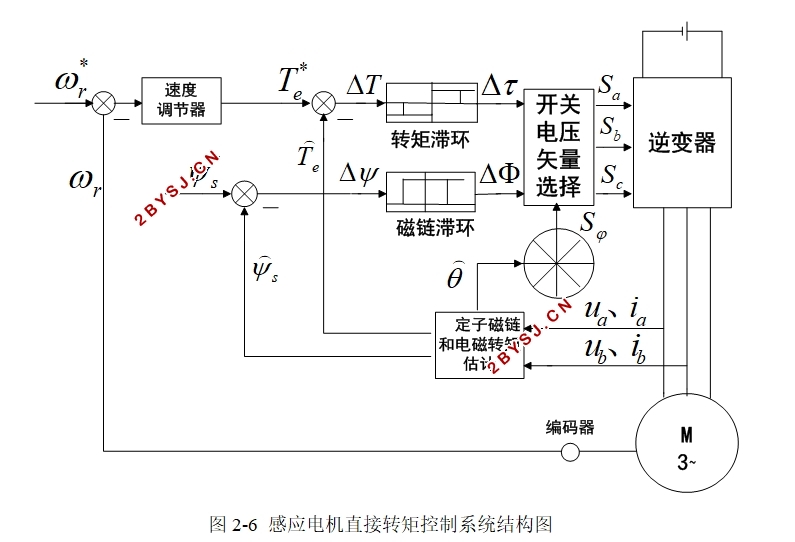感应电机的效率最优控制研究
无需注册登录,支付后按照提示操作即可获取该资料.
感应电机的效率最优控制研究(任务书,开题报告,外文翻译,论文13800字)
摘要
感应电机由于结构简单、坚固耐用、体积小、重量轻、可靠性高和价格低廉等特点而被广泛应用于工业、农业等领域。作为一种高性能电机控制方法,直接转矩控制具有控制结构简单、动态响应快、受电机参数变化影响小等优点,广泛应用于感应电机驱动控制。而在实际应用中,感应电机直接转矩控制系统往往处于轻载运行状态,导致电机运行效率低、电能损耗大。因此,如何提高感应电机直接转矩控制系统的运行效率,已经成为人们关注的重要课题。
本文首先给出了感应电机的数学模型,详细阐述了直接转矩控制原理。在分析感应电机损耗特性的基础上,忽略了定、转子漏感,采用定子磁场定向,建立了计及铁损时感应电机的数学模型,研究了不同负载转矩和转速条件下电机损耗与定子磁链之间的关系,通过优化定子磁链实现感应电机直接转矩控制系统的效率最优控制。分析了定、转子铜耗、铁损与定子电流及转速的关系,导出不同运行状态下(不同转矩和转速)电机损耗最小或效率最高时的最优定子磁链表达式。采用MATLAB/SIMULIN.K.建立了直接转矩控制系统的仿真模型,对基于损耗模型的效率优化控制进行了仿真研究。仿真结果表明,该控制方法能有效的提高感应电机直接转矩控制系统的运行效率。
关键词:感应电机 直接转矩控制 功率损耗 效率优化 节能
The Efficiency Optimization Control of Induction Motor
ABSTRACT
Induction motor has been widely applied in industry, agriculture and other fields, because of its simple structure, durable, small size, light weight, high reliability and low prices. As a high-performance motor control method, Direct Torque Control (DTC) has simple structure, fast dynamic response and robust characteristics, widely used in IM drive control. However, in practical applications, the system of asynchronous motor-DTC often operates in light conditions, which leads to the efficiency low, and energy wasted. So it is a generally concerned topic how to improve the operating efficiency of the system of asynchronous motor-DTC.
This paper first gives a mathematical model of induction motor and elaborating on the principle of DTC. On the basis of detailed analysis of the asynchronous motor's losses characteristics and the optimal control principle of efficiency, the mathematical model of induction motor considering iron loss is established. Using the stator flux-oriented, and ignore the stator and rotor leakage inductance, the relationship between the motor losses and the stator flux in different load torque and speed is investigated in details. The efficiency optimization control strategy of direct torque controlled induction motor drives, which minimizes the motor losses by optimizing the stator flux magnitude, is proposed. By analysis of the relationship between stator、rotor copper loss, iron loss and stator current and speed, the expression of stator flux magnitude which minimizes power losses or optimal efficiency is determined in different operating conditions (different torque and speed). The simulation model of DTC system is established with MATLAB / SIMULINK, the efficiency optimization Control for Loss-Mode-Based Control is studied. The simulation results show that the control strategies can improve the efficiency of asynchronous motor-DTC.
KEYWORDS: Induction motor; direct torque control; power loss; efficiency optimization; energy saving


目录
摘要 I
ABSTRACT II
目录 III
第一章 绪论 1
1.1 课题背景 1
1.2 直接转矩的发展及现状 1
1.3感应电机的节能运行控制技术 2
1.3.1 基于损耗模型的控制 3
1.3.2 在线搜索控制 3
1.3.3 最小定子电流控制 4
1.3.4 效率优化控制方法存在的问题 4
1.4 本课题研究的主要内容 5
第二章 感应电机直接转矩控制的基本原理 6
2.1 感应电机的数学模型 6
2.1.1 两相静止坐标系下感应电机的方程 6
2.1.2 坐标变换 7
2.2 逆变器及电压空间矢量 8
2.3 直接转矩控制原理 10
2.3.1 直接转矩控制的基本结构 10
2.3.2 定子磁链和转矩估计 11
2.3.3 直接转矩控制的实现 12
2.4 本章小结 14
第三章 感应电机效率优化控制策略 15
3.1 感应电机的效率与损耗分析 15
3.1.1感应电机的损耗分析 15
3.1.2 感应电机的效率 16
3.2 计及铁损的感应电机数学模型 17
3.3 基于损耗模型的控制 18
3.3.1 最优定子磁链的推算 18
3.3.2 基于损耗模型的效率优化框图 22
3.4 本章小结 22
第四章 感应电机直接转矩控制系统效率优化的仿真 24
4.1 MATLAB/SIMULINK简介 24
4.2 效率优化控制系统的仿真模型 24
4.2.1 计及铁损的感应电机仿真模型 24
4.2.2 磁链、转矩观测器模型 27
4.2.3 磁链、转矩和速度调节器模型 28
4.2.4 电压矢量选择模型 29
4.2.5 基于损耗模型的效率优化控制模型 30
4.3仿真结果与分析 30
4.3.1 计及铁损的感应电机仿真结果 30
4.3.2 效率优化控制策略的仿真结果与分析 32
4.4 本章小结 35
第五章 总结与展望 36
参考文献 37
致谢 40
